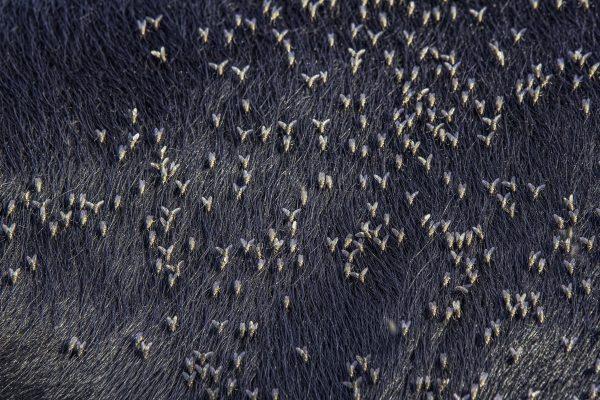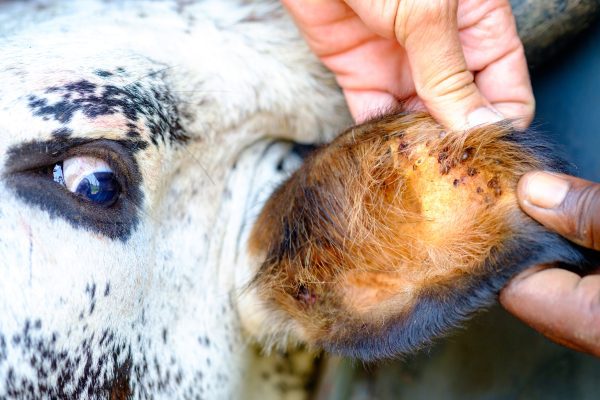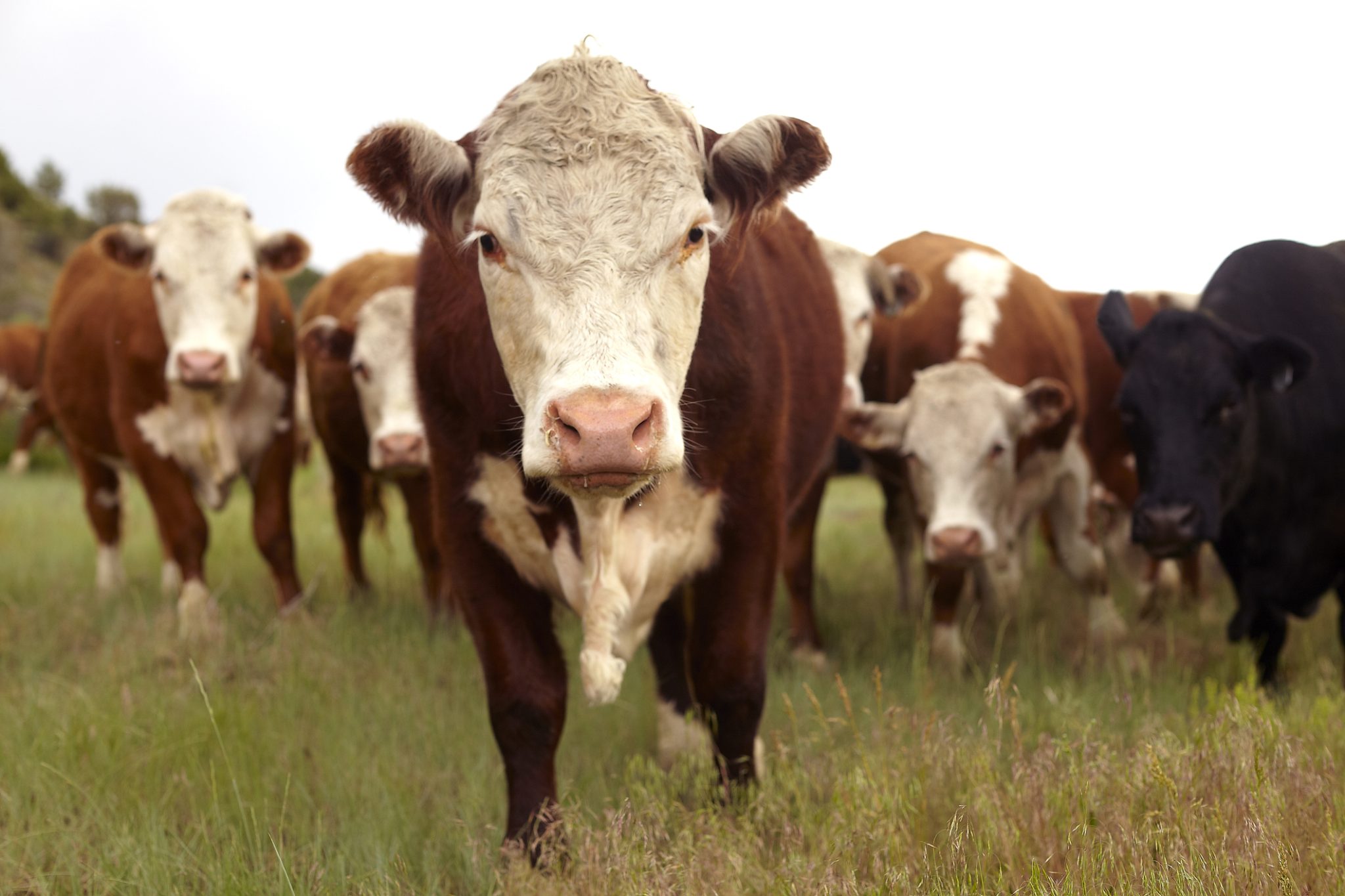In Beef What Is the Parasite Mange Mites
Beef cattle production represents a multibillion dollar industry in the southeastern United States. External parasites (ectoparasites) are those that live and feed on the outside of the animal. These pests directly affect the producer's bottom line by causing decreased weight gain, decreased milk production, loss in hide value, and potential disease transmission. Lack of external parasite control costs beef producers billions of dollars each year.
Integrated Pest Management
To be successful in the control of external parasites, producers need to take an integrated approach to pest management. Integrated pest management (IPM) uses a variety of pest control tactics (biological, cultural, and chemical control) to reduce overall pest pressure. IPM strategies are pest specific and will vary based on the biology of the pest you are trying to control; therefore, proper pest identification should always be the first step in the process.
Biological Control
Proper identification of insect populations is imperative to make sound pest control decisions, as many of the insects that we encounter are harmless to both humans and animals. Some insects are even beneficial in the fight against common cattle pests either through predation or competition for resources. Examples include black dump fly larvae, which are known to feed on house fly larvae developing in the same manure. Soldier fly larvae will outcompete horn fly and house fly larvae for food, which leaves the pests without the necessary resources to fully mature. Some of the more commonly discussed biological controls in livestock operations are dung beetles and parasitic wasps. Dung beetles will actively remove manure, making the pats dry faster and the environment unsuitable for fly development. Several species of parasitic wasps, marketed as biological controls of cattle pests, are commercially available. The wasps lay eggs inside immature horn flies, house flies, and stable flies. The wasp larva then eats the immature flies. It should be noted that wasps can be used to supplement sanitation but probably will not control pests below economic thresholds. This is especially true when the environment favors pest development.
Cultural Control
Cultural controls are practices that manipulate the pest's environment to reduce conditions that are suitable for development. Make sure to quarantine and treat new animals before they are introduced into the herd to reduce chances of lice, mite, or tick infestations. Reducing breeding conditions through proper management and sanitation is the most effective way to control cattle pests.
- Use hay rings or roll out hay to reduce waste. Trampled hay that is urinated or defecated on is the primary breeding site of many cattle pests.
- Avoid feeding hay in the same location each time.
- Use pasture rotation and proper stocking rates to allow manure to dry out and decompose.
- In areas where cattle congregate, remove manure and spread thinly on pastures to allow it to dry properly.
- Remove and dispose of carcasses quickly and properly.
- Keep pastures cut or properly grazed to decrease thatch and associated moisture, which aid in pest development.
- Keep water troughs clean and in proper working order. Eliminate areas that hold stagnate water to reduce mosquito breeding sites.
Chemical Control
Many pesticides are available that are labeled for external parasites of beef cattle. Pesticides should be used only when other methods are ineffective or unavailable. Economic thresholds, the point at which chemical control measures are economically justified, should be used when making treatment decisions. Always read and follow label directions. The pesticides listed in this document are meant only as a reference guide, not as full label directions or recommendations.
Insecticide Application Methods
Dips
Dip vats are used to treat a large number of animals in an efficient manner. Vats provide good coverage of the animal being treated to ensure effective control. Use only products labeled for dip vat treatments and follow directions when filling and recharging.
Dusts
Most commonly, dusts are applied using self-treatment dust bags that are recharged throughout the season. Place dust bags in areas where animals are forced to use them: heading toward feed troughs, waterers, and mineral feeders, for example. Dust bags are most effective when placed at the animals shoulder height. Placing dust bags under cover will allow them to stay dry and prevent caking.
Ear Tags
Ear tags deliver slow-release insecticide over time via a plastic tag placed in the ear of the animal. Ear tags typically control flies for 3 to 5 months and ear ticks for 4 to 5 months. They do a good job of controlling horn flies, stable flies, lice, mosquitoes, and ticks. Follow the label in regard to the number of tags per animal. Most brands require two tags per mature animal; applying fewer than the recommended rate will not save money but will increase pest resistance to the insecticide.
Feed-Throughs
Feed-through products are insecticides that are mixed with either feed or mineral supplements. They pass through the animal's digestive system and control immature flies developing in the manure. Adult flies will migrate from nearby herds, so feed-through products are most effective when the herd is isolated from other herds or used in addition to a topical treatment method. Consistent intake is imperative, so animals need unlimited and continual access to the feed/mineral for the products to be effective. Feed-throughs take time to build up in the system and become effective, so make sure to follow the label about when to start (typically 3 to 4 weeks before fly season) and finish feeding products during the fly season. Feed-through insecticides are not digested, so the products never get into blood or meat; therefore, they have no effect on adult flies.
Injectables
Some active ingredients are formulated for sucutaneous injection in beef cattle. These products are labeled for cattle grubs and lice as well as for internal parasite control.
Pour-Ons
Pour-on products are made to be applied down the length of the animal's backline and sometimes down the center of the face. They are then absorbed into the skin and act as systemic insecticides. They may control horn flies for up to 30 days.
Spot-On
These systemic products are applied to a specific area along the animal's back. They require specially designed applicators and are most effective for control of cattle grubs and lice.
Sprays
Sprays are meant to be applied as a coating across the entire animal. Only mix and prepare the amount needed to treat the number of animals. Do not store or use mixed insecticides. Emulsifiable concentrates or soluble formulations are well suited for small sprayers. Wettable powders require a high-volume piston pump sprayer with agitator. For ticks, lice, and mites, use enough water to cover the animal thoroughly. When spraying systemic insecticides to control cattle grubs, be sure to wet the animals to the skin.
External Parasites of Beef Cattle in the Southeast
Horn Fly
 Horn flies (Haematobia irritans) are one of the most economically important pests of beef cattle in the United States. Adult horn flies are small (3/16 inch) and are similar in color to house flies. They spend most of their adult life on the animal (back, sides, and belly) where they feed on blood 30 to 40 times per day, using piercing mouthparts that inflict a painful bite. Their persistent biting causes cattle to react with evasive maneuvers (tail flicking, side licking, stomping, kicking their bellies, huddling together). Cattle spend more time trying to rid themselves of horn flies than they do eating or drinking, leading to weight loss, decreased milk production, dehydration, and weakness. Adult horn flies live about 3 weeks and leave the animal only to lay eggs under the edge of fresh manure pats. Development takes approximately 10 to 20 days. When horn flies exceed the economic threshold of 200 flies per side, weight gain will be affected, and calves can lose up to 15 percent of their body weight. Use of chemical controls is necessary once this economic threshold is reached (see options in table 1).
Horn flies (Haematobia irritans) are one of the most economically important pests of beef cattle in the United States. Adult horn flies are small (3/16 inch) and are similar in color to house flies. They spend most of their adult life on the animal (back, sides, and belly) where they feed on blood 30 to 40 times per day, using piercing mouthparts that inflict a painful bite. Their persistent biting causes cattle to react with evasive maneuvers (tail flicking, side licking, stomping, kicking their bellies, huddling together). Cattle spend more time trying to rid themselves of horn flies than they do eating or drinking, leading to weight loss, decreased milk production, dehydration, and weakness. Adult horn flies live about 3 weeks and leave the animal only to lay eggs under the edge of fresh manure pats. Development takes approximately 10 to 20 days. When horn flies exceed the economic threshold of 200 flies per side, weight gain will be affected, and calves can lose up to 15 percent of their body weight. Use of chemical controls is necessary once this economic threshold is reached (see options in table 1).
Chemical control options come in a variety of delivery methods: back rubs, dust bags, ear tags, feed-throughs, injections, pour-on liquids, and sprays. Different delivery methods will work depending on your herd management plan. Make decisions based on your system.
- Wait to use topical control measures until you reach the 200 flies per side economic threshold.
- Rotate chemical classes of insecticides each season to prevent resistance.
- Remove ear tags at the end of each fly season or when the tags become ineffective (economic threshold is reached).
- Avoid combination ear tags because they promote resistance to multiple insecticide classes simultaneously.
- Place back rubs and dust bags in areas where cattle are forced to use them; good examples are gates that cattle must go through to access water, feed troughs, or mineral feeders. It may take time for cattle to become acclimated to these devices.
- When using insect growth regulator feed-through products, begin to feed early in the spring and feed through the first frost. Consistent intake is essential, so make sure animals have constant, equal access to the product.
Stable Fly
Stable flies (Stomoxys calcitrans) have a major economic impact to the US cattle industry. Adults feed on the blood of the animal and are painful biters. Unlike horn flies that stay on the animal, stable flies will feed once per day and then leave the animal to rest on nearby surfaces (vegetation, barn walls, etc.). Adults are similar in size to house flies (about 1⁄4 inch long), and they lay their eggs in decaying vegetation that has been mixed with urine or feces. Stable flies will attack the legs, sides, backs, and bellies of cattle, causing evasive maneuvers (stomping, belly kicking, tail switching, bunching). Cattle spend more time trying to rid themselves of flies than eating or drinking, leading to weight loss, decreased milk production, dehydration, and energy loss. Extreme bunching can also reduce the cattle's ability to dissipate heat during the hot and humid days of summer. Chemical control action must be taken when the economic threshold of two to four flies per leg is noted (see options in table 1).
- Remove old or trampled hay bales.
- Use hay rings to reduce waste and to reduce amount of hay that will be trampled, urinated, and defecated on.
- Rotate hay feeding locations to reduce accumulation and to allow previous hay feeding locations to dry properly.
- Remember that biological controls that attack horn fly larvae will also attack stable fly larvae.
- Spray animals and resting sites with approved insecticides to provide immediate control.
Pesticide Suggestions for Horn Flies and Stable Flies
Note: Table 1 is a comprehensive list of available chemical control products labeled for horn flies and stable flies. Alabama Extension does not promote one product over another. Make sure to read and follow all label instructions and guidelines. The table is organized by insecticide formulation, then by class of insecticide. Rotation between insecticide classes is key to successful resistance management.
Cattle Grub (Heel Fly)
Heel fly adults are large hairy flies with a black and yellow color pattern that resembles bumble bees. Female heel flies lay their eggs on the lower body of cattle, typically the legs, in early spring. When eggs hatch, larvae (cattle grubs) penetrate the skin of the animal and begin to migrate through the body in late spring or early summer. They cluster in the esophagus or spinal column, then ultimately migrate to the back of the animal in late summer. Once in the back region of the animal, the larvae form cystlike structures called warbles, typically in early fall. This habit often gives the flies the name "warble flies." The grubs cut a respiratory opening in the skin and continue to develop in the back for another 6 to 8 weeks, at which point they enlarge the hole, exit, and drop to the ground to pupate.
Presence of heel flies causes cattle to run wildly and erratically with their tails raised in the air, called "gadding." Affected animals may also stand in water to avoid flies. Cattle grubs are a costly pest for cattle producers, reducing weight gain, lowering milk production, and damaging hides.
When implementing controls, the time line of the life cycle is important because cattle can experience a host/parasite reaction if control measures are taken at the wrong time. Host/parasite reactions occur when systemic insecticides are used too late in the season, when cattle grubs are congregated in the animal's esophagus, spinal column, or back. When grubs are in the esophagus and insecticides are applied, the grubs will die, but this triggers an immune response in the animal leading to swelling of the esophagus, bloat, increased salivation, and death. When grubs are in the spinal column and insecticides are applied, the grubs will die, and the reaction will cause paralysis of the back legs. This paralysis is often temporary. Because of the potential host/parasite reaction, control through prevention in spring is preferred.
Pesticide Suggestions for Cattle Grubs
Note: Table 2 is a comprehensive list of available chemical control products labeled for cattle grub. Alabama Extension does not promote one product over another. Make sure to read and follow all label instructions and guidelines. Consult your veterinarian before treatment.
Blow Fly
Blow fly adults are large and easily identified by their metallic green, black, or blue coloration. Blow flies lay their eggs in dead/necrotic tissue, dog feces, and wet garbage. They can often be observed around carrion, or around open/necrotic wounds on animals. Blow fly maggots will sometimes infest dehorning/castration/ branding wounds, navels of young calves, and other open wounds that occur due to accidental injury. If infestations go unmonitored, they can become severe and lead to death, especially in young calves and animals already in poor body condition.
- Dispose of dead animals properly to avoid blow flies.
- Keep garbage in sealed containers and away from cattle facilities.
- Treat any infested wounds with a topical insecticide from table 3 according to label directions until maggots are gone.
Screwworm Fly
Like other blow fly species, screwworm flies infest dead animals, wounds, and necrotic tissue. The primary screwworm (Cochliomyia hominivorax) is endemic to the Western Hemisphere but has been mostly eradicated in the United States since the 1950s through the use of sterile insect technique. In 2016, a population of primary screwworm was identified in key deer in the Florida Keys. Through federal quarantine and eradication efforts, this event was isolated. Unlike most blow fly species, primary screwworm lays its eggs in an existing wound on an animal, and the larvae feed only on living tissues. These wounds can be as small as a tick bite. The feeding of maggots can lead to death of the animal in severe infestations.
The secondary screwworm (Cochliomyia macellaria) is known to infest dead tissue, with adults laying their eggs in the natural openings of fresh carcasses. Secondary screwworm adults rarely lay eggs on living animals.
Primary screwworm flies are a federally regulated pest. Report any suspected cases to your local veterinarian, Extension agent, or state veterinary office. New infestations of screwworm are always possible, so make sure to isolate new animals before introducing them into the existing herd.
Pesticide Suggestions for Blow Fly/Screwworm Fly Larvae
Note: Table 3 is a comprehensive list of available chemical control products labeled for blow flies and screwworm flies. Alabama Extension does not promote one product over another. Make sure to read and follow all label instructions and guidelines. The table is organized by insecticide formulation, then by class of insecticide. Rotation between insecticide classes is key to successful resistance management.
Other Biting Flies
Black Fly
Black flies are small humpbacked flies that are typically present in the early spring across the southeast. They are found attached to submerged stones or wood in fast-moving water, which provides the aeration for the larvae necessary for development. They are known to overwhelm livestock, including cattle, and can cause asphyxiation (suffocation) when they swarm in large numbers. The adults inflict a painful bite and can cause cattle to stampede and act erratically when present.
- Treating cattle with any of the topical products previously listed for horn/stable flies will limit the number of black fly attacks.
- Providing shelter can help limit attack.
- White petroleum jelly and permethrin-based repellents can be used on ears to limit attack.
- Larvicides are available to treat water sources. This is often the best line of defense.
Horse/Deer/Yellow Flies
Horse, deer, and yellow flies are all members of the biting fly family Tabanidae. The female flies are painful and aggressive biters that can have serious impacts to beef cattle in the southeast. They cause cattle to lose weight and can also transmit diseases such as anaplasmosis and anthrax. They inhabit low-lying areas that tend to stay wet and have overgrown vegetation. Control of tabanid flies can be extremely difficult. The topical insecticides available are ineffective, and no insecticides will kill the immature stages of these flies.
- Provide cattle with shelter and barriers as the most effective strategy.
- Control overgrown vegetation where possible.
- Use box and canopy traps to capture and limit the number of adult flies.
Mosquitoes
Mosquitoes are a common biting fly attacking both humans and animals in the southeast. Female mosquitoes are blood feeders and require a blood meal to lay eggs. Eggs are laid on water or in an area that will be inundated with water. Both temporary and permanent water sources, such as water troughs, ponds, lakes, floodwaters, tidal pools, tree holes, discarded tires, bird baths, etc., are used by mosquito species for the immature stages of development. Mosquitoes can cause loss of weight and thriftiness when present in large numbers. They can also transmit multiple diseases.
- Use the topical insecticides previously listed for horn fly/stable fly to control and repel mosquitoes.
- Treat the immature stages of mosquitoes with insecticidal dunks. Many are safe and suitable for use in water troughs and small bodies of water.
- Eliminate standing water where possible.
- Turn over buckets, feeders, etc., to prevent them from holding water.
- Control overgrown vegetation where possible.
Lice
Lice that feed on cattle are common in the southeast, with most infestations occurring in the winter and early spring months. Lice can cause weight loss, anemia, decreased milk production, and lameness. They can also spread anaplasmosis. Heavy infestations can be debilitating and lead to death in young calves, older cows, or animals already in poor body condition.
Lice spread from animal to animal via direct contact; therefore, isolating and treating new animals is key before introducing them to the herd. There are five species of lice that feed on cattle in the southeast.
- The cattle biting louse (Bovicola bovis) can often be found on the topline of animals and feeds on hair and skin scales.
- The longnosed cattle louse (Linognathus vituli) sucks the blood of the animal and prefers to feed on the back, neck, and shoulders of the animal.
- The shortnosed cattle louse (Haematopinus eurysternus) sucks the blood of the animal and prefers to feed on the top of the neck and around the brisket, and typically prefers mature animals rather than calves.
- The cattle tail louse (Haematopinus quadripertusus) sucks the blood of the animal and prefers to feed on the last 18 inches of the tail. Heavy infestations can sometimes be found in the ears.
- The little blue cattle louse (Solenoptes capillatus) sucks the blood of the animal and prefers to feed on the faces of cattle.
Inspect and treat cattle for lice in late fall or early winter. Control can be achieved by either timed treatments or the use of self-treatment devices. Retreatment is imperative because none of the insecticides provide control for the egg stage of lice. Follow label directions for proper treatment and retreatment strategies.
Pesticide Suggestions for Lice
Note: Table 4 is a comprehensive list of available chemical control products labeled for lice. Alabama Extension does not promote one product over another. Make sure to read and follow all label instructions and guidelines. The table is organized by insecticide formulation, then by class of insecticide. Rotation between insecticide classes is key to successful resistance management.
Mites
Several different mite species affect and feed on cattle in the southeast. They fall into two different categories: mange mites and scab mites. Mange mites will burrow into the skin of the animal where the female will then deposit her eggs inside. Scab mites will deposit their eggs at the base of hair just under the skin surface. Four main species of mites affect cattle in the southeast:
- Cattle follicle mite (Demodex bovis) will cause nodules just under the skin surface. These nodules can be felt but are not easily seen. The nodules will vary from pinhead to golf ball in size. Over time, nodules will rupture, and cattle can be observed exuding cheese-like puss from the wounds.
- Chorioptic scab mites (Chorioptes bovis) prefer to feed on the legs and feet of cattle, where they can cause mange that presents as crusted-over lesions. This is often called "itchy heel" or "foot mange" and is easily spread via contact with infected animals.
- Psoroptic scab mites (Psoroptes bovis) causes mange that presents as general swelling and skin dermatitis. They feed by scratching the skin surface, which causes the initial irritation. They spread rapidly through herds when present via direct contact or from infested objects (fence posts, working chutes, etc.).
- Scabies mites (Sarcoptes scabiei) burrow into the skin of cattle where they live. Cattle have immune reactions to the feces of the mites, which initially causes small lesions and then quickly spreads all over the body. If left untreated, lesions will cause skin to thicken and crust over. Cattle will exhibit as generally irritated, scratching themselves on whatever they can find. This often leads to secondary infections.
Chorioptic, psoroptic, and scabies mites are all regulated pests, and infestations are required to be reported to state veterinary offices. Work with your local veterinarian to report and treat these mite infestations. Mite infestations are typically worse in the winter months; preventative treatment in the fall is often the best course of action.
Pesticide Suggestions for Mites
Note: Table 5 is a comprehensive list of available chemical control products labeled for mites. Alabama Extension does not promote one product over another. Make sure to read and follow all label instructions and guidelines. The table is organized by insecticide formulation, then by class of insecticide. Rotation between insecticide classes is key to successful resistance management.
Ticks
 Many tick species feed on cattle in the southeast. Ticks can spread numerous diseases and can cause weight loss, decreased milk production, reduction in hide value, and anemia when very high populations are present. Clearing overgrown brush, proper grazing management, and preventing cattle from entering the woods are good ways to reduce tick infestations. Many pesticide options are available to aid in tick management. Different tick species prefer to feed on different areas of the host animal. Choosing a control product that targets the areas of the animal where most of the ticks are found is the best tactic. For example, some tick species will invade the ears of their hosts (example: spinose ear ticks): for such pests, insecticidal ear tags are often the best defense.
Many tick species feed on cattle in the southeast. Ticks can spread numerous diseases and can cause weight loss, decreased milk production, reduction in hide value, and anemia when very high populations are present. Clearing overgrown brush, proper grazing management, and preventing cattle from entering the woods are good ways to reduce tick infestations. Many pesticide options are available to aid in tick management. Different tick species prefer to feed on different areas of the host animal. Choosing a control product that targets the areas of the animal where most of the ticks are found is the best tactic. For example, some tick species will invade the ears of their hosts (example: spinose ear ticks): for such pests, insecticidal ear tags are often the best defense.
Pesticide Suggestions for Ticks
Note: Table 6 is a comprehensive list of available chemical control products labeled for ticks. Alabama Extension does not promote one product over another. Make sure to read and follow all label instructions and guidelines.
Note: Products listed in this document are for reference only. We do not promote one product over another. Make sure to read and follow all label instructions and guidelines. This document was created and adapted from "Managing External Parasites of Texas Cattle" E-570 by Dr. Sonja Swiger. This publication was made possible through funding from the SSARE grant program.


 Kelly Palmer, Regional Extension Agent, Livestock and Forages, Auburn University; Sonja Swiger, Associate Professor, Extension Entomologist, Texas A&M AgriLife Extension; Nancy Hinkle, Professor, Extension Veterinary Entomologist, University of Georgia Extension; Kelly Loftin, Professor, Medical and Veterinary Entomology, University of Arkansas Extension
Kelly Palmer, Regional Extension Agent, Livestock and Forages, Auburn University; Sonja Swiger, Associate Professor, Extension Entomologist, Texas A&M AgriLife Extension; Nancy Hinkle, Professor, Extension Veterinary Entomologist, University of Georgia Extension; Kelly Loftin, Professor, Medical and Veterinary Entomology, University of Arkansas Extension
New November 2021, Managing External Parasites of Beef Cattle in the Southeast, ANR-2838
Source: https://www.aces.edu/blog/topics/beef/managing-external-parasites-of-beef-cattle-in-the-southeast/

0 Response to "In Beef What Is the Parasite Mange Mites"
Post a Comment